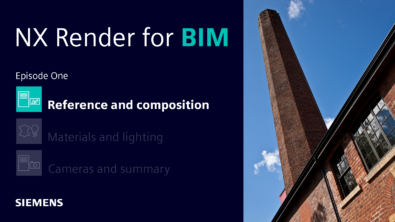NX Render for BIM | Cameras and summary

We’re delighted to bring you the final entry into our NX™ software render for BIM series. As a reminder, we’re taking you through a typical end-to-end workflow for creating high-quality, photo-realistic renders whilst using NX. Our first episode focused on the importance of reference imagery, whilst our second episode looked at how to use materials and lighting to bring a scene to life. Take a look below if you’ve missed them.
In our final episode, we’ll be taking a look at camera placement, and how well placed cameras can help create a truly stunning render. Additionally, we’ll also summarize the workflow, whilst exploring how NX is different from other software.
This series has taken inspiration from architecture found in an area of Sheffield, United Kingdom. The area is known for its industrial background, but has seen a renaissance in recent years. The result? stunning architectural projects that merge the industrial with modernism.
And with that, let’s catch-up with Greg Arnot and Gavin McCambridge.

Greg Arnot
We looked at composition in a previous episode, but how does that inform a user’s decision on camera placement?
Gavin McCambridge
So we’ve got our model, we’ve got our references, we have applied our materials. The next step I would personally recommend is to choose your camera views; this is where you need to think about composition. One of the biggest things with rendering is composition four your image. You can have a lovely model with excellent materials, lighting, everything, but if your composition is poor, your imagery will be poor. You know that what you’re creating will not have the impact you want. So placing your cameras is an important part of the process.


Greg Arnot
And how are cameras added to a scene?
Gavin McCambridge
Adding cameras in NX is simple; each scene comes with preset orthographic cameras, top, front, trimetric, etc. You can add new cameras or work with the presets. Cameras can be positioned and edited with basic settings that simulate the functions of a physical camera.
After setting up some initial camera views, I would spend time reviewing the work thus far by creating some draft renders. If I was doing this for a client, I’d actually invite them to do a simple review using what we call a white model (i.e. without realistic materials, just a matte white material applied to the entire model), or something similar. Just very simple. The objective is to get them to sign up to proposals of what we’re going to do.

Greg Arnot
Could you compare where NX render and 3ds Max sit together?
Gavin McCambridge
We’re not comparing like with like. 3ds Max is more of a visualization tool, NX is primarily an engineering tool. So, it’d be unfair to do an NX against 3ds Max comparison. But my opinion is we get a kind of a balance between Revit and 3ds Max with NX.
Where NX is better is that we’re not asking users to learn to be a visualizer. NX render is very straightforward to use, there are a lot of presets already in there. Some of the core systems like the cameras you’ll have probably used before, as cameras are not just used for visualization, so many of the concepts required for NX render are not completely new to standard NX users. The idea is that it’s simple to use.
Just looking at our team, we have team members who started six, seven, months ago, and they are consistently producing visuals of an amazing quality. You know, I doubt you could do the same (using other products). It’s very intuitive.

Greg Arnot
If cameras are not just for visualization, what else would they be used for?
Gavin McCambridge
When I said visualization, I was meaning photorealistic visualization. Visualization is an incredibly broad term, for example, the standard NX viewport, with basic CAD colouring, no advanced shading, is also a form of visualization. Visualization essentially just means the process of creating a visual from information, e.g. data visualization. However, when we use the term in our industry, we are typically referring to photorealistic, ray-traced renders of 3D models.
So, cameras in NX are not just for ‘high-end’ visualization, they’re also for setting up views of your model and similar tasks. If you are working on design reviews for your model, you may have a certain set of cameras that you always use to review something with. For consistency.

Greg Arnot
At what stage in the project can the designer show a render?
Gavin McCambridge
Any stage you like. Once you’ve created a model, you can do a render. One of the biggest issues that we find is that whenever you’re showing something to a customer, the customer tend to think that what you’re showing them is a finished piece because the render quality is so high, when you still have design work to do. So using a ‘white model’ or a model with just one material over the whole thing, is a way to indicate to the viewer that this is a draft piece of work. You can show the form of your design, but it’s clear you are not showing something finalized at that point.

Greg Arnot
Could you summarize the process of creating a render in NX? What is the next step?
Gavin McCambridge
I guess the simple way of explaining the process of creating a render, is to start with references, establish initial camera positions, apply materials to your model. And then we start moving into things like lighting, creating the environment the model sits in. When we’re doing lighting and materials, we may need to do them at the same time. Because they interact with each other, it is an iterative process. This applies to the whole project really; as a basic workflow I would set up initial cameras, materials, lighting, but then I would return to these to refine them as the project progresses.
Draft renders are important for this, once you have a basic setup, you can use draft renders to review the work you have done so far. You can show these to the customer or client to see whether they’re happy with it and then adjust your setup in response to any comments they may have.

Greg Arnot
How does the workflow in NX compare to other similar software?
Gavin McCambridge
For example, when I worked in arch vis (architectural visualization), we mainly used a piece of BIM software called Revit to create our models. Now with Revit, generally you wouldn’t render so much in the actual software, most Revit content goes out into 3ds Max because they’re both Autodesk products, they exist in the same ecosystem. But that means that when you export from Revit to 3ds Max, you’ve got to ‘material’ everything up in 3ds Max; create a lighting setup; do your whole visualization workflow there. It’s a separate piece of software.
If you make any design changes in Revit, they don’t come through to your 3ds Max setup automatically, whereas if you make a design change in NX, that is immediately reflected in your renders. It makes design iterations much faster, as you can view them in a high-quality render straight away, without having to jump back and forth between software packages. It’s a simpler workflow. Basically, what we have with NX is a time saver.

Greg Arnot
Do you think this is something that is going to be interesting to architects and builders, and if so, why?
Gavin McCambridge
I do. I think there is massive value in having powerful rendering functionalities within the core product itself, being able to make updates, alterations, where you’re already working. You’ve not got an elongated workflow out to different (software) packages. But you have the option to do that as well if you want to. NX gives you the flexibility to choose.
It’s all about time saving. Being able to update models in NX and then simply press render to get an updated view out.

Greg Arnot
Why wouldn’t I just use a free sketching tool?
Gavin McCambridge
Well, sketching tools don’t have the functionality of a CAD package. They are intended for freer ideation, usually early on in the design process. Whatever you sketch, you will then take through into a CAD tool to workup. You can then use this to generate engineering drawings. The idea of sketching tools is to put ideas down, but you can manufacture or build whatever you’re designing straight from NX. It contains the full toolset for engineering, for construction. You can’t generate all the information you need to from a free sketching tool.

Greg Arnot
Is what we offer now within NX sufficient for what most architects and engineers are going to need?
Gavin McCambridge
Yes, is the simple answer. It is a bit more nuanced than that, though. Lots of other tools will have wider functionality in specific areas, but what we offer within NX is a single package that contains pretty much everything you are likely to want. You don’t need to jump back and forth between different pieces of software to get quality results. NX is a very powerful CAD system, with plenty of tools for design, manufacture, and engineering, but it also comes with an excellent built in renderer for creating visuals, which is quite a unique combination.
Conclusion
And that concludes our NX Render for BIM series. We hope you have taken valuable insights from our three part series. Make sure to continue your journey with NX by checking out our blog site and learn more about NX.
Take me to the NX design blog📚

Gavin McCambridge, Creative Team Manager, Siemens Digital Industries Software
With over 20 years of experience at the cutting edge of 3D visualization, Gavin now leads an expert team of creatives and 3D artists who are pushing the boundaries of high-end visualization using NX. Working across automotive to aerospace and consumer products to AEC, Gavin’s attention to detail enables him to create some of the most visually stunning content ever produced with NX. His passion for helping others to learn NX visualization is born out through his contributions to blogs and learning materials.

Greg Arnot, Product Marketing Manager, Siemens Digital Industries Software
Greg’s electronics career commenced in the 1990s at Hewlett-Packard in Barcelona, Spain. He served in product management and global business development positions within the Inkjet Commercial Division until 2004, when he founded a wireless startup focusing on social proximity applications for Facebook. Later, he led the U.S. operations of GreenPowerMonitor, a top solar monitoring firm. In February 2020, Arnot joined UltraSoC’s product management team, which Siemens DISW acquired in October 2020. Subsequently, he transitioned to the Siemens NX team in June 2022.

Comments
Leave a Reply
You must be logged in to post a comment.



The text sparks my curiosity and thirst for knowledge. Area Code